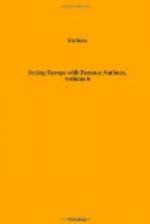The view from this library is really enchanting, and put everything seen from a similar situation at Landshut and almost even at Chremsminster, out of my recollection. You look down upon the Danube, catching a fine sweep of the river, as it widens in its course toward Vienna. A man might sit, read, and gaze—in such a situation—till he fancied he had scarcely one earthly want! I now descended a small staircase, which brought me directly into the large library—forming the right wing of the building, looking up the Danube toward Lintz. I had scarcely uttered three notes of admiration, when the Abbe Strattman entered; and to my surprise and satisfaction, addrest me by name. We immediately commenced an ardent unintermitting conversation in the French language, which the Abbe speaks fluently and correctly.
I now took a leisurely survey of the library; which is, beyond all doubt, the finest room of its kind which I have seen upon the Continent—not for its size, but for its style of architecture, and the materials of which it is composed. I was told that it was “the Imperial Library in miniature,”—but with this difference, let me here add, in favor of Moelk—that it looks over a magnificently wooded country, with the Danube rolling its rapid course at its base. The wainscot and shelves are walnut tree, of different shades, inlaid, or dovetailed, surmounted by gilt ornaments. The pilasters have Corinthian capitals of gilt; and the bolder or projecting parts of a gallery, which surrounds the room, are covered with the same metal. Everything is in harmony. This library may be about a hundred feet in length, by forty in width. It is sufficiently well furnished with books, of the ordinary useful class, and was once, I suspect, much richer in the bibliographical lore of the fifteenth century.
On reaching the last descending step, just before entering the church, the Vice-Principal bade me look upward and view the corkscrew staircase. I did so; and to view and admire was one and the same operation of the mind. It was the most perfect and extraordinary thing of the kind which I had ever seen—the consummation, as I was told, of that particular species of art. The church is the very perfection of ecclesiastical Roman architecture; that of Chremsminster, altho’ fine, being much inferior to it in loftiness and richness of decoration. The windows are fixt so as to throw their concentrated light beneath a dome, of no ordinary height, and of no ordinary elegance of decoration; but this dome is suffering from damp, and the paintings upon the ceiling will, unless repaired, be effaced in the course of a few years.




